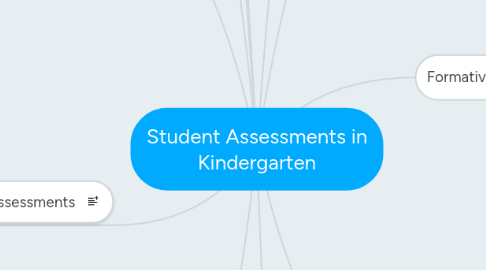
1. Performace Based Assessments
1.1. Advantages
1.1.1. Student are enabled and more responsible for the demonstration of their learning than in traditional multiple-choice style assessments.
1.1.2. More applicable to the real world and helps to promote 21st century skills in students.
1.1.3. Great for students who experience traditional testing anxiety as it allows them to demonstrate knowledge in more natural way.
1.2. Disadvantages
1.2.1. Can be difficult to implement in a large class setting
1.2.2. İt can be difficult to design PB-assessments for some topics.
1.3. Assessment of learning
1.4. Example
2. High-Stakes Assessments
2.1. Assessment of learning
2.2. Disadvantages
2.2.1. Put a amount of pressure on both students and teachers.
2.2.2. A less natural way for students to demonstrate knowledge.
2.2.3. Students can become very demotivated by the results and rank themselves to their peers.
2.2.4. Do not highlight student progress, rather they compare to a standard.
2.2.5. Don't take into account SE or ELL students extra needs.
2.3. Advantages
2.3.1. Results are easily analysed
2.3.2. Results give perspective of achievement on a much larger scale.
2.4. Example
3. Authentic Assessments
3.1. Assessment of and for learning
3.2. Advantages
3.2.1. Allows students to show their skills and knowledge in a more natural way
3.2.2. Less pressured than traditional exams
3.3. Disadvantages
3.3.1. Harder to quantitatively measure student achievement
3.3.2. Not all topics lend themselves to this type of assessment.
3.4. Example
4. Peer-Assessments
4.1. Assessment for learning
4.2. Disadvantages
4.2.1. Sometimes students are too kind to their peers so may mark the work at a higher standard than it is.
4.2.2. Opportunities for bullying can arise.
4.3. Advantages
4.3.1. Allows students to see others perspective on the subject.
4.3.2. Can help to build a sense of community and team work in the classroom.
4.4. Example
5. References
5.1. Neason, A. (2015). High-Stakes Testing Has Trickled All the Way Down to Kindergarten. Retrieved June 19, 2016, from http://www.slate.com/blogs/schooled/2015/03/04/kindergarten_has_changed_less_time_for_play_more_time_for_standardized_tests.html
5.2. Authentic Assessment Overview. (n.d.). Retrieved June 19, 2016, from https://www.teachervision.com/teaching-methods-and-management/educational-testing/4911.html
5.3. Performance Based Assessment. (n.d.). Retrieved June 19, 2016, from http://www.teach-nology.com/currenttrends/alternative_assessment/performance_based/
6. References
7. Diagnostic Assessments
7.1. Assessment for learning
7.2. Disadvantages
7.2.1. Can be initially demotivating for students that have a low level of student readiness.
7.3. Advantages
7.3.1. Allows teachers to find any specific gaps of knowledge common to all students.
7.3.2. Allows tailoring of the unit or course specifically for individual students for differentiation.
7.4. Example
8. Formative Assessments
8.1. Assessment for learning
8.2. Disadvantages
8.2.1. Students may not place importance on them.
8.3. Advantages
8.3.1. Can be performed very quickly with little preparation
8.3.2. Results allow for teachers to resolve learning issues before its too late. They can correct problems in real time.
8.3.3. Can take a large range of forms allowing them to be created to suit a variety of learning styles.
8.4. Example
9. Summative Assessments
9.1. Assessment of learning
9.2. Disadvantages
9.2.1. Can put a lot of pressure on students if they are aware as it will reflect on their learning for the whole unit.
9.2.2. May not represent the students true abilities if the students style does not match the assessment.
9.3. Advantages
9.3.1. Encourages students to utilise all the skills and knowledge they have acquired and therefore pushes them to revisit the topics at the end of a unit.
9.3.2. Demonstrates clearly they success of the unit to the teacher and can demonstrate progress when compared to the students pre-assessment.
9.4. Example
10. Portfolios
10.1. Assessment for and of learning
10.2. Disadvantages
10.2.1. Can be very time consuming for the teacher and student.
10.2.2. Some students do not react well to 1-1 portfolios and become much more reserved.
10.3. Advantages
10.3.1. Students get to see a visual representation of their progress which can be very motivating in terms of seeing how much they have improved.
10.3.2. Students are provided with the opportunity to reflect on their own work promoting deeper thinking and a more broad view on the topic they have been working on.
10.3.3. Doesn't require students to memorize and regurgitate information - they are required to think about the topic to show their understanding.
10.4. Example
11. Self-Assessments
11.1. Assessment of and for learning
11.2. Disadvantages
11.2.1. Students may not self-assess harshly enough to avoid embarrassment and therefore miss out on a learning opportunity.
11.3. Advantages
11.3.1. Gets students to think critically about their own work.
11.3.2. Students think from the eyes of a teacher and can understand more deeply what is expected of them.
11.3.3. Students reflect and learn in the process.
11.3.4. Students can keep the results private from their peers if they feel embarrassed.

